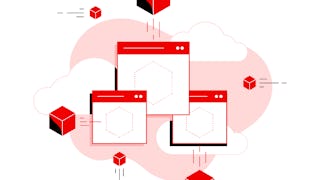Take the next step in your software engineering career by getting skilled in container tools and technologies! The average salary for jobs that require container skills is $137,000 in the US according to salary.com, making Devops professionals and developers with these skills highly in demand. More than 70 percent of Fortune 100 companies are running containerized applications. But why?

Enjoy unlimited growth with a year of Coursera Plus for $199 (regularly $399). Save now.

Introduction to Containers w/ Docker, Kubernetes & OpenShift
This course is part of multiple programs.


Instructors: Alex Parker
146,819 already enrolled
Included with
(1,026 reviews)
Recommended experience
What you'll learn
Using containers, learn how to move applications quickly across any environment.
Build cloud native applications using Docker, Kubernetes, OpenShift, and Istio.
Describe and leverage Kubernetes architecture to set up and use an entire lifecycle-based container management system.
Create and leverage a YAML deployment file to configure and create resources such as pods, services, replicasets, and others in a declarative way.
Skills you'll gain
Details to know

Add to your LinkedIn profile
See how employees at top companies are mastering in-demand skills

Build your subject-matter expertise
- Learn new concepts from industry experts
- Gain a foundational understanding of a subject or tool
- Develop job-relevant skills with hands-on projects
- Earn a shareable career certificate from IBM

There are 5 modules in this course
Start your first week by learning about container concepts, features, use cases, and benefits. Building on your new knowledge of containers, you’ll learn what Docker does and discover why Docker is a winner with developers. You’ll learn what Docker is, become acquainted with Docker processes, and explore Docker’s underlying technology. Learn about how developers and organizations can benefit from using Docker and see which situations are challenging for using Docker. Next, learn how to build a container image using a Dockerfile, how to create a running container using that image, become familiar with the Docker command line interface (CLI), and explore frequently used Docker commands. You’ll become knowledgeable about Docker objects, Dockerfile commands, container image naming, and learn how Docker uses networks, storage, and plugins. Then, assimilate this knowledge when you see Docker architecture components in action and explore containerization using Docker. At the end of this first week, you’ll pull an image from a Docker Hub registry. You’ll run an image as a container using Docker, build and tag an image using a Dockerfile, and push that image to a registry.
What's included
6 videos2 readings2 assignments2 app items5 plugins
In week two, learn what container orchestration is. Then, explore how developers can use container orchestration to create and manage complex container environment development lifecycles. Kubernetes is currently the most popular container orchestration platform. You’ll examine key Kubernetes architectural components, including control plane components and controllers. Explore Kubernetes objects, and learn how specific Kubernetes objects such as Pods, ReplicaSets, and Deployments work. Then, learn how developers use the Kubernetes command line interface (CLI), or “kubectl” to manipulate objects, manage workloads in a Kubernetes cluster, and apply basic kubectl commands. You’ll be able to differentiate the benefits and drawbacks of using imperative and declarative commands. At the end of this module, you will use the kubectl CLI commands to create resources on an actual Kubernetes cluster. At the end of this week, you’ll use the Kubernetes CLI to create a Kubernetes pod, create a Kubernetes deployment, create a ReplicaSet and see Kubernetes load balancing in action.
What's included
6 videos1 reading2 assignments2 app items4 plugins
In week three, you’ll explore ReplicaSets, autoscaling, rolling updates, ConfigMaps, Secrets, and service bindings, and learn how you can use these capabilities to manage Kubernetes applications. You’ll learn how ReplicaSets scale applications to meet increasing demand, and how autoscaling creates dynamic demand-based scaling. You’ll see how to use rolling updates to publish application updates and roll back changes without interrupting the user experience. You’ll learn how to use ConfigMaps and Secrets to provide configuration variables and sensitive information to your deployments and to keep your code clean. At the end of the week, you’ll scale and update applications deployed in Kubernetes.
What's included
5 videos2 readings2 assignments2 app items3 plugins
In week four, you’ll learn more about the growing Kubernetes ecosystem and explore additional tools that work well with Kubernetes to support cloud-native development. You’ll gain an understanding of the similarities and differences between Red Hat ® OpenShift® and Kubernetes and see what OpenShift architecture looks like. You’ll learn about OpenShift builds and BuildConfigs, and OpenShift build strategies and triggers. You'll also discover how operators can deploy whole applications with ease. Finally, you’ll examine how the Istio service mesh manages and secures traffic and communication between an application’s services. At the end of the week, you’ll use the oc CLI to perform commands on an OpenShift cluster. And you’ll use the OpenShift build capabilities to deploy an application from source code stored in a Git repository.
What's included
4 videos1 reading2 assignments1 app item3 plugins
For the Final Project, you will put into practice the tools and concepts learned in this course, and deploy a simple guestbook application with Docker and Kubernetes. The entire application will be deployed and managed on OpenShift.
What's included
3 readings1 peer review6 app items3 plugins
Earn a career certificate
Add this credential to your LinkedIn profile, resume, or CV. Share it on social media and in your performance review.
Instructors


Offered by
Explore more from Cloud Computing
 Status: Preview
Status: Preview Status: Free Trial
Status: Free Trial Status: Free Trial
Status: Free Trial
Why people choose Coursera for their career




Learner reviews
1,026 reviews
- 5 stars
66.37%
- 4 stars
19%
- 3 stars
5.06%
- 2 stars
4.87%
- 1 star
4.67%
Showing 3 of 1026
Reviewed on Apr 27, 2022
Very good intro to Containers, good content. I didn't give 5 stars because there are some bugs that make you lose time during the lab sessions, especially the last - and longest - one.
Reviewed on Sep 25, 2025
It`s a good overview of the capabilities, basic usecases, maybe a littlebit more indepth knowledge, or tricks and tips would have been nice. Like an everyday use case screnario.
Reviewed on Jun 22, 2021
Very good introduction to the basic concepts of Containerization and Kubernetes. Good examples to get a starting feel on how to work with such tools

Open new doors with Coursera Plus
Unlimited access to 10,000+ world-class courses, hands-on projects, and job-ready certificate programs - all included in your subscription
Advance your career with an online degree
Earn a degree from world-class universities - 100% online
Join over 3,400 global companies that choose Coursera for Business
Upskill your employees to excel in the digital economy
Frequently asked questions
This course does not have rigid prerequisites, but we recommend that you complete “Introduction to Cloud Computing” and have the following skills: • Basic computer and an understanding of core cloud concepts • An understanding of the command line and shell commands
We recommend that you complete “Introduction to Cloud Computing before taking this course.
To access the course materials, assignments and to earn a Certificate, you will need to purchase the Certificate experience when you enroll in a course. You can try a Free Trial instead, or apply for Financial Aid. The course may offer 'Full Course, No Certificate' instead. This option lets you see all course materials, submit required assessments, and get a final grade. This also means that you will not be able to purchase a Certificate experience.
More questions
Financial aid available,
¹ Some assignments in this course are AI-graded. For these assignments, your data will be used in accordance with Coursera's Privacy Notice.


